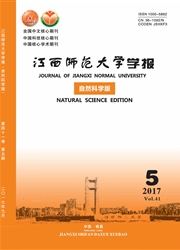

 中文摘要:
中文摘要:
由9,9-二(4-羟基苯基)呫吨和对氯硝基苯反应制得二硝基化合物,继而用水合肼/钯碳将其还原得到二胺——9,9-二(4-氨基苯氧基苯基)呫吨(BAPX)。采用Yamazaki聚合体系,将BAPX与1,4(或2,6)-萘二酸进行缩聚合成了两种新型含呫吨和萘环结构的聚酰胺,二者均为无定型结构,其特性黏度、玻璃化转变温度(Tg)分别为0.98dL/g和1.0dL/g、295℃和302℃。在氮气和空气气氛中,10%的热失重温度(Td10)均在505℃以上,在氮气中,800℃时的残炭率大于65%;在常温下易溶于N-甲基-2-吡咯烷酮(NMP)、N,N-二甲基乙酰胺(DMAc)和间甲酚等极性溶剂中,可通过溶液浇铸成透明、韧性的薄膜,膜的拉伸强度、断裂伸长率和杨氏膜量依次分别为105MPa和110MPa、13.1%和13.3%、2.88GPa和3.05GPa。
 英文摘要:
英文摘要:
Reaction of 9,9-bis(4-hydroxyphenyl)xanthene with 4-nitrchlorobenzene afforded the corresponding dinitro compound,followed by reduction in the presence of hydrazine hydrate and Pd/C catalyst to give a novel diamine monomer,9,9-bis(4-aminophenoxyphenyl)xanthene (BAPX). Two novel aromatic polyamides containing xanthene and naphthylene moieties with the inherent viscosities (1.0 dL/g~0.98 dL/g) were prepared from BAPX with 1,4-naphalenedicarboxylic acid and 2,6-naphalenedicarboxylic acid using Yamazaki method via direct polycondensation,respectively. The new polyamides were amorphous and readily soluble in polar solvents such as N,N-dimethylacetamide (DMAc),N-methyl-2-pyrrolidinone (NMP) and m-cresol. These polymers show relatively high glass transition temperatures of 295 ℃ and 302 ℃,10% weight loss temperatures is above 500 ℃ both in nitrogen and air,and char yield at 800 ℃ in nitrogen is higher than 65%. Transparent and flexible films of the two polymers cast from DMAc solutions exhibit tensile strengths,elongations at break and initial moduli of 105 MPa and 110 MPa,13.1 and 13.3%,2.88 GPa and 3.05 GPa,respectively.
 同期刊论文项目
同期刊论文项目
 同项目期刊论文
同项目期刊论文
 Synthesis and Characterization of Novel Soluble Cardo Poly(arylene ether ketone)s Containing Xanthen
Synthesis and Characterization of Novel Soluble Cardo Poly(arylene ether ketone)s Containing Xanthen Novel soluble fluorinated aromatic polyamides derived from 2-(4-trifluoromethylphenoxy)terephthaloyl
Novel soluble fluorinated aromatic polyamides derived from 2-(4-trifluoromethylphenoxy)terephthaloyl Synthesis and properties of novel organosoluble aromatic poly(ether ketone)s containing pendant meth
Synthesis and properties of novel organosoluble aromatic poly(ether ketone)s containing pendant meth 期刊信息
期刊信息
